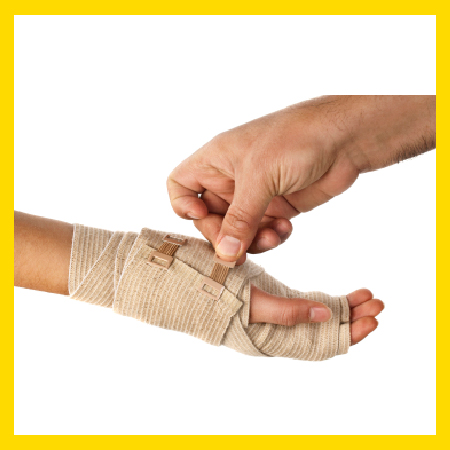Currency
August 01, 2018

All too often, hand injuries occur when employees are distracted and aren't focused on where they are or what they're doing. It's incredibly important for employers to eliminate as many distractions as possible.
According to the U.S. Bureau of Labor Statistics (BLS), more than 1 million workers are sent to the emergency room each year because of serious hand injuries. From lacerations and cuts to burns and broken bones, these injuries can be costly for employers. In 2011, the National Safety Council estimated the cost of hand injuries, and the results may be surprising to some employers: The direct cost of a laceration can be $10,000, stitches are often $2,000, and a severed tendon can be more than $70,000. It's also important to note that these numbers don't account for the indirect costs, like time away from work and lost productivity due to long-term damage, that are associated with even minor hand injuries.
The good news is that with the right tools, resources and education, many workplace hand injuries can be prevented. In order to protect employees from injury and reduce workers' compensation costs, employers need to first understand the who, what, where, when, and why of hand injuries.
Everyone is potentially at risk for hand injuries. Regardless of gender, age, or industry, employers should always take steps to protect employees from even minor bumps and bruises. However, there are certain groups of employees who may be at a higher risk. Less-experienced workers, for example, or those whom the Occupational Safety and Health Administration considers to be new to the workforce, may be at higher risk for injuries at work. Whether it's due to less on-the-job experience or a heightened sense of pressure to complete tasks quickly, employers should take special care especially with less-experienced workers. Make sure new hires feel comfortable speaking up about safety concerns and create a comfortable work environment where questions are both welcome and encouraged. Safety training is also an important step, especially for younger workers who are new to the industry and unfamiliar with common, and potentially hazardous, machinery and tools.
Employers also should take steps to make sure workers over the age of 55 are protected. While less likely to be injured on the job given their level of experience, workers in this age group often require a longer recovery time and may sustain more serious injuries when they do get hurt at work. According to BLS, workers ages 55 and older can require a median of 12 to 14 days away from work after a non-fatal injury, while workers between the ages of 20 and 44 typically require only 5 to 9 days. This may result in costs stemming from days off work and lost productivity. Employers can help workers in this age group prevent injury by implementing a workplace wellness program that encourages a focus on ergonomics, stretching, and healthy lifestyles. Pay special attention to any previous injuries or illnesses that may make it difficult for any worker to properly lift heavy objects or see thin blades on a piece of machinery.

The hands are incredibly versatile, but they're also exposed to a variety of threats that can result in injuries ranging from minor cuts and bruises to serious lacerations and burns. Some of those injuries include lacerations, crushes, avulsions or detachments, punctures, and fractures.
Lacerations.
Lacerations are deep cuts or tears in the flesh. While most lacerations are easily treated, nerve or tendon damage is possible if the cut is deep. This can result in longer recovery time and possible long-term damage.
Crushes.
Crushes occur when a body part—in this case, the hand, wrist, or arm—is caught between heavy equipment or machinery and another hard surface, like the floor or a wall. Depending on severity, this type of injury often causes permanent damage, particularly in cases where the crush injury prevents blood supply to the muscles.
Avulsion fractures or detachments.
Avulsion fractures are fractures that occur when a bone is moving one way and a tendon or ligament is moving or pulled in the opposite direction. A common avulsion injury occurs when a wedding ring or other piece of jewelry gets caught on machinery and pulls a small piece of bone that is attached to a tendon or ligament away from the main part of the bone. Detachments can occur the same way but are typically more serious and often involve entire fingers or hands becoming separated from the body.
Punctures.
Punctures often involve sharp objects, such as nails, needles, knives, tacks, machinery, or other tools. Punctures occur when one of these objects penetrates the skin and causes a wound that is typically narrower and deeper than a cut or scrape.
Fractures. A fracture, or a break in one of the bones of the hand, is often caused by trips, falls, and crushes. Fractures occur in the bones of the wrist and typically require weeks to months of recovery time.
According to the U.S. Bureau of Labor Statistics (BLS), more than 1 million workers are sent to the emergency room each year because of serious hand injuries. From lacerations and cuts to burns and broken bones, these injuries can be costly for employers. In 2011, the National Safety Council estimated the cost of hand injuries, and the results may be surprising to some employers: The direct cost of a laceration can be $10,000, stitches are often $2,000, and a severed tendon can be more than $70,000. It's also important to note that these numbers don't account for the indirect costs, like time away from work and lost productivity due to long-term damage, that are associated with even minor hand injuries.
The good news is that with the right tools, resources and education, many workplace hand injuries can be prevented. In order to protect employees from injury and reduce workers' compensation costs, employers need to first understand the who, what, where, when, and why of hand injuries.
Who is At Risk for Hand Injuries?
Everyone is potentially at risk for hand injuries. Regardless of gender, age, or industry, employers should always take steps to protect employees from even minor bumps and bruises. However, there are certain groups of employees who may be at a higher risk. Less-experienced workers, for example, or those whom the Occupational Safety and Health Administration considers to be new to the workforce, may be at higher risk for injuries at work. Whether it's due to less on-the-job experience or a heightened sense of pressure to complete tasks quickly, employers should take special care especially with less-experienced workers. Make sure new hires feel comfortable speaking up about safety concerns and create a comfortable work environment where questions are both welcome and encouraged. Safety training is also an important step, especially for younger workers who are new to the industry and unfamiliar with common, and potentially hazardous, machinery and tools.
Employers also should take steps to make sure workers over the age of 55 are protected. While less likely to be injured on the job given their level of experience, workers in this age group often require a longer recovery time and may sustain more serious injuries when they do get hurt at work. According to BLS, workers ages 55 and older can require a median of 12 to 14 days away from work after a non-fatal injury, while workers between the ages of 20 and 44 typically require only 5 to 9 days. This may result in costs stemming from days off work and lost productivity. Employers can help workers in this age group prevent injury by implementing a workplace wellness program that encourages a focus on ergonomics, stretching, and healthy lifestyles. Pay special attention to any previous injuries or illnesses that may make it difficult for any worker to properly lift heavy objects or see thin blades on a piece of machinery.

What Types of Hand Injuries Are the Most Common?
The hands are incredibly versatile, but they're also exposed to a variety of threats that can result in injuries ranging from minor cuts and bruises to serious lacerations and burns. Some of those injuries include lacerations, crushes, avulsions or detachments, punctures, and fractures.
Lacerations are deep cuts or tears in the flesh. While most lacerations are easily treated, nerve or tendon damage is possible if the cut is deep. This can result in longer recovery time and possible long-term damage.
Crushes occur when a body part—in this case, the hand, wrist, or arm—is caught between heavy equipment or machinery and another hard surface, like the floor or a wall. Depending on severity, this type of injury often causes permanent damage, particularly in cases where the crush injury prevents blood supply to the muscles.
Avulsion fractures are fractures that occur when a bone is moving one way and a tendon or ligament is moving or pulled in the opposite direction. A common avulsion injury occurs when a wedding ring or other piece of jewelry gets caught on machinery and pulls a small piece of bone that is attached to a tendon or ligament away from the main part of the bone. Detachments can occur the same way but are typically more serious and often involve entire fingers or hands becoming separated from the body.
Punctures often involve sharp objects, such as nails, needles, knives, tacks, machinery, or other tools. Punctures occur when one of these objects penetrates the skin and causes a wound that is typically narrower and deeper than a cut or scrape.









